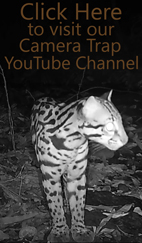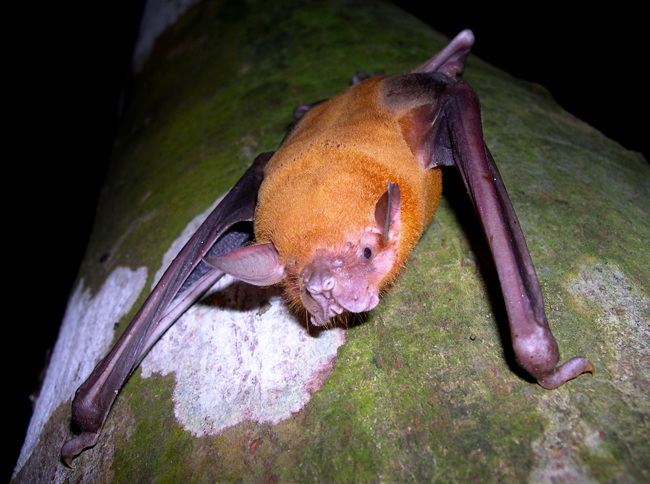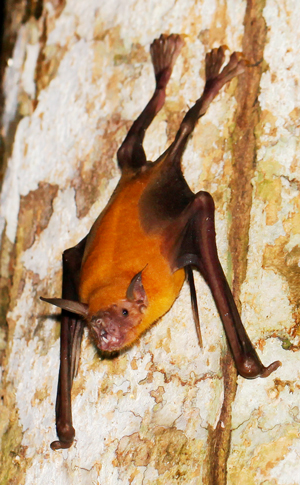|
Discover
the hidden treasures of Drake Bay, Costa Rica with Tracie
"The Bug Lady"

Home

Tour
Basics

Meet
the Bug Lady

Tales
from the Edge

Media

Reservations

Links



Facts about Drake Bay, Costa Rica

Travel To
Drake Bay

Drake Bay
Area Map

Hotel
Information

Tips for Travelers

Tours

Recommended
Reading




|
|
 |

The Greater BullDog
Fishing Bat
Noctilio leporinus
|
 |
|

The Greater Fishing
Bat, Noctilio leporinus, is
one of the most spectacular mammals
one can hope to encounter in Drake
Bay. With pointed ears, small
eyes, prominent cheeks, and large
canine teeth - these denizens of
the dark bear an uncanny resemblance
to bulldogs, hence their common name
Bulldog Bats.
Bulldogs are large
bats, with an average wingspan of
60cm. They boast bright orange
fur (although shades of brown occur as
well). Perhaps their most
striking feature, though, are the
greatly enlarged hind feet.
Equipped with long, sharp claws, these
feet allow the bulldogs to feed on
prey almost no other bat in the
world can - fish!
|
|
|
 Canoeing
across the Agujitas River at night, between
Aguila de Osa Inn and Drake Bay Wilderness
Resort, Gianfranco and I encounter colonies of
Bulldog Fishing Bats most nights. The
Bulldogs use their acute sonar to detect
ripples on the water's surface created by
small fish. Once the bat has honed in on
the fish, it will rake its hind feet through
the water, gaffing its prey. Canoeing
across the Agujitas River at night, between
Aguila de Osa Inn and Drake Bay Wilderness
Resort, Gianfranco and I encounter colonies of
Bulldog Fishing Bats most nights. The
Bulldogs use their acute sonar to detect
ripples on the water's surface created by
small fish. Once the bat has honed in on
the fish, it will rake its hind feet through
the water, gaffing its prey.
The
fish may then be eaten while in flight or
stored in its modified cheeks and eaten later
at a feeding perch. If the bat should
accidentally tumble into the water while
hunting, they do swim quite well. Once
the bat reaches the shore, it will climb up
the nearest tree or vertical surface until it
is high enough to become airborne
again.
|
|
|

|
|
 Gianfranco's
photographs of the Bulldog Fishing Bats featured here
were taken at a feeding perch, a large tree, near the
suspension bridge that spans the Agujitas
River. Gian and I have been observing the
Bulldogs at this same perch for several years. Gianfranco's
photographs of the Bulldog Fishing Bats featured here
were taken at a feeding perch, a large tree, near the
suspension bridge that spans the Agujitas
River. Gian and I have been observing the
Bulldogs at this same perch for several years.
On
nights when the ocean is calm, the bats will
hunt saltwater fish in the bay, as well as the
river. Studies have shown that a single bat may
consume up to 40 fish a night. Most of these
fish measure between 2 to 8 cm in length.
Bulldogs
will also eat insects, shrimp, crabs, and even
frogs. They will hunt prey overland too.
Flying insects, which are caught on the wing may
actually make up more than half the diet at certain
times of year, particularly in rainy season.
|
|
According
to C. Brandon in Costa Rica Natural
History Noctilio leporinus bats adapt
quite well to captivity:
"Within
a day or two of capture it will
spontaneously learn to eat from a dish of
fish or mealworms placed in the cage. Taming
is also rapid, and within a few days the
bats can be held in the hand without trying
to escape....These bats are also easy to
train for experimental work. They quickly
learn to do a variety of tasks."

Greater
Bulldog Bat feeding on a fish - Noctilio
leporinus |
John
Kricher, in his wonderfully informative book A
Neotropical Companion recounts how he
once shared a hotel room with a Bulldog
Fishing Bat his colleague captured to bring to
the U.S. for study. The bat spent the evening
dining on a bucket of fish while hanging form
a picture frame in the bathroom. "The fact
that the bat reeked of fish and strong musk,
plus the constant sound of fish bones being
ground up", said Kricher, "made for fitfull
sleeping that night." Captive bats have lived
11.5 years.
During
the day, Bulldog Fishing Bats roost in caves,
the crevices of rocks, hollow trees, and
sometimes buildings. Colonies may number
several hundred bats, although we have never
found such large groups in Drake Bay.
|
|
References:
Beletsky, L.
2005 Travellers' Wildlife Guides Costa
Rica Interlink Publishing
Janzen, D. 1983
Costa Rican Natural History University
of Chicago Press
Kricher, J. 1989 A Neotropical
Companion Princeton University Press
LaVal, R. & Rodriguez, B. 2002
Murcielagos de Costa Rica/Bats Editorial
INBio
Wainwright, M. 2002 The Natural
History of Costa Rican Mammals Zona
Tropical
Wilson, D. 1997 Bats in
Question Smithsonian Institution Press
|
Click
below for more information about Gian's
book!

|
|
|
|
Mammal Files











|



 Alien
Earthlings
Alien
Earthlings  The Dark Side
The Dark Side







 Canoeing
across the Agujitas River at night, between
Aguila de Osa Inn and Drake Bay Wilderness
Resort, Gianfranco and I encounter colonies of
Bulldog Fishing Bats most nights. The
Bulldogs use their acute sonar to detect
ripples on the water's surface created by
small fish. Once the bat has honed in on
the fish, it will rake its hind feet through
the water, gaffing its prey.
Canoeing
across the Agujitas River at night, between
Aguila de Osa Inn and Drake Bay Wilderness
Resort, Gianfranco and I encounter colonies of
Bulldog Fishing Bats most nights. The
Bulldogs use their acute sonar to detect
ripples on the water's surface created by
small fish. Once the bat has honed in on
the fish, it will rake its hind feet through
the water, gaffing its prey.
 Gianfranco's
photographs of the Bulldog Fishing Bats featured here
were taken at a feeding perch, a large tree, near the
suspension bridge that spans the Agujitas
River. Gian and I have been observing the
Bulldogs at this same perch for several years.
Gianfranco's
photographs of the Bulldog Fishing Bats featured here
were taken at a feeding perch, a large tree, near the
suspension bridge that spans the Agujitas
River. Gian and I have been observing the
Bulldogs at this same perch for several years. 











